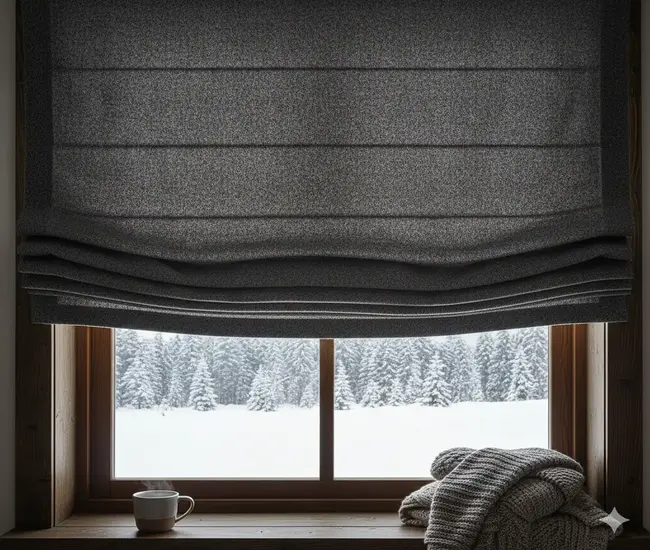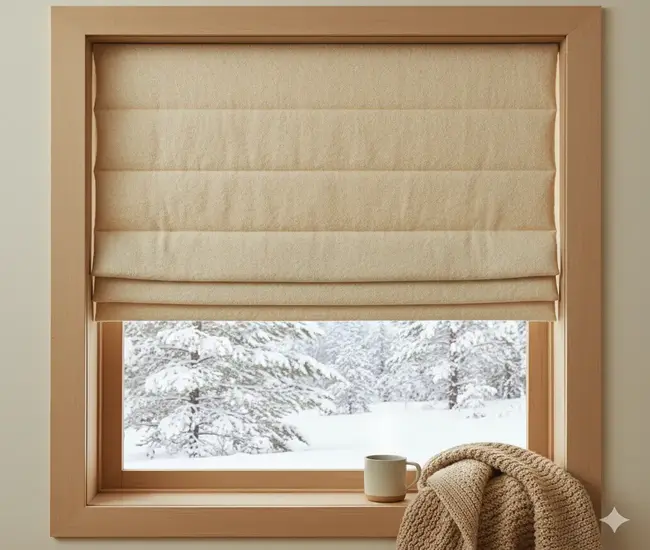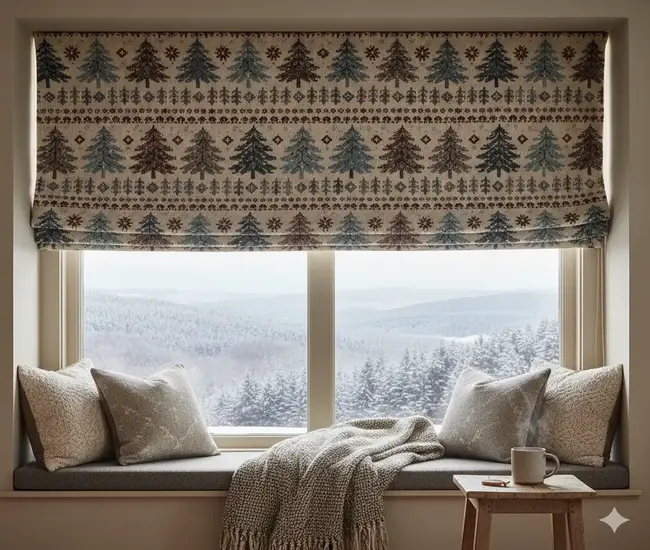Looking for winter Roman blinds to keep cold out and save over 10% on heating costs? Thick fabric thermal Roman shades with folded, air-trapping design will help keep cold drafts out and help retain warmth of the cooling systems. This post explores the insulating properties of winter-optimized Roman blinds with their pros and cons, and more.
According to CBS News – news division of the American CBS Television network – average heating costs of homes are $634, $1,179, and $1,518 for natural gas, propane, and heating oil, respectively for 2024. These costs are expected to rise in 2025 and onwards.
Now have a look at the energy saving potential of winter Roman blinds. According to the US Department of Energy, when installed with a tight fit, insulated window blinds can decrease heat loss through windows by 40% or more, which equals about 10% heating cost savings in heating seasons. It means, you can save at least $63 to $151 with insulated Roman blinds and shades.
With their power to repel external cold, winter Roman blinds will further add to overall energy consumption bills. Similarly, these window coverings will also be beneficial in summer, i.e., they can reduce solar heat gain by up to 60% in the cooling season.
If you need even better (or the best possible!) all-weather insulation, consider double cellular shades. Cellular shades are already a top recommendation by the United States Energy Department for insulation in both winter and summer.
Scroll on to learn more about winter Roman blinds.
What Are Winter Roman Blinds?
WInter Roman blinds are specialized thermal Roman shades with added insulating properties to keep external cold out and prevent internal heat from escaping through the windows. They also provide privacy, light control, & noise rejection. Meanwhile, being typical Roman style window coverings, winter Roman blinds instantly elevate the look, feel, and functionality of any space.
Winter Roman Blinds vs Summer Roman Blinds – 5 Key Differences
| Sr. | Winter Roman Blinds | Summer Roman Blinds |
| 1. | Cold-blocking & heat-retaining properties | Heat-blocking and cooling-retaining properties |
| 2. | Light filtering design (to let in solar warmth in winter) | Light reflecting design (to prevent harmful UVs and heatwaves from entering your living space) |
| 3. | Made from thicker, folded fabrics | Made from relatively thin, flat fabric panels |
| 4. | Heavier, thermal-lined fabrics to trap heat | Lighter, unlined, breathable fabrics for some degree of ventilation |
| 5. | More expensive (cost of a sturdy blind plus a liner) – $200 to $800 per window treatment. | Less expensive (only a slim fabric panel) – $150 to $700 per window treatment. |
What to Do with Summer Roman Shades That Are Still Usable?
- Option 1: Unhang, wrap, and pack summer Roman shades and store them in a dry, moisture-free space. Also spray them with insecticides to keep beetles, crickets, and other fabric-eating insects away.
- Option 2: Keep them hanging and pair them with a thermal, cold-insulating liner. This will be the most affordable option to insulate your windows in winter, costing just around $15 to $20 per window.
- Option 3: Donate your reusable summer blinds to a charity like Habitat for Humanity ReStore that functions in each of the 50 states.
6 Cold-Repellent Winter Roman Window Treatments With Pros & Cons
1. Pleated Roman Shades – Create Insulating Honeycomb Effect With Crisp Folding
Pros
- Air-trapping pleated design that mimics honeycomb construction and function
- A blend of classic aesthetic (of Roman shades) with modern functionality cellular blinds
- Can also make your home quieter by absorbing outside noise
- Can be customized to fit any window size and shape, to the fraction (1/8th) an inch
- Create a tailored look with customizable fabric color & quality
- Lightweight folded fabric, stiffened with a thin layer of glue, creating a beautiful accordion effect
- Best for living rooms, dining areas, bedrooms, & home offices
Cons
- Costlier than ordinary flat panel Roman blinds
- Difficult to clean, as stiffened fabric pleats will collect, dust, dirt, and pollens
- More susceptible to mechanical damage from pets and children
- Less resistant to moisture and mildew – unsuitable for vapor-rich areas like kitchens and bathrooms
Typical Price Range
The average price of Plain Pleated Roman Shade – Exquisite ranges between $150 to $625, based on size (12×16” to 115×120”) and quality.
Note
Pleated Roman shades are versatile and gorgeous window coverings like honeycomb blinds. But, unlike honeycomb blinds’ cellular compartments, they are made of a single layer of material that’s folded and refolded to create a pleated look.
Design Tip to Enhance Winter Warmth
Choose pleated Roman shades in bold colors to complement the warmth-enhancing theme of interior decor. Ann, an experienced interior designer at AffordableBlinds.com, recommends deep blues for bedrooms and rich reds for living rooms.
2. Thick Fabric Relaxed Roman Shades – Get Drape-like Winter Resistance

Pros
- Thick fabric layers (wool, velvet, cotton) – effective thermal protection in winter
- Can provide 99% room darkening or 100% blackout
- Extra thick ‘bonded’ lining doubles the potential of the blinds to keep heat in
- Won’ t sway in winter winds, thanks to weighty material
- Available in 100% pure linen gauze, if you need filtered light from winter sun
Cons
- Bulkiness adds to the difficulty of lift the fabric up
- Being fabric-based, they require more upkeep compared to smooth-slatted aluminum & faux wood blinds
- Moisture sensitive, not a good choice for bathrooms and laundry rooms
Typical Price Range
The average cost of an ’Elite’ version of a relaxed Roman shade is between $160 and $800 for windows measuring 30” wide x 16” high to 115” wide x 120” high, excluding the cost of a liner and installation charges.
Design Tip
Joanna Gaines, a renowned American interior decorator and founder of the lifestyle brand Magnolia with 13.4M following on Instagram, has been spotted on her TV shows using gray patterned relaxed Roman shades to create a continuous, cohesive look.
3. Flat Fold Roman Shades Paired with Thermal Roller Blinds – The Best Duo for Winter Protection
Pros
- Aesthetic & functional – stylish 2-layer system for excellent energy efficiency
- Near-best 2-in-1 combination for near-perfect cold control
- Each window covering can be independently rolled up/down to precisely adjust the level of light in your room
- Blackout thermal roller blind will guarantee complete darkness and privacy
Cons
- If a roller blind is layered exterior to the Roman shade, it will hide the classic charm of the Roman shade.
- The duo (Roman plus roller) will make your window covering appear bulky
- Low sheerness – can completely obstruct view to the outside when closed
Typical Price Range
An “Essential” model of a flat fold Roman shades costs $180 to $560 on average. And a basic version of blackout roller blinds is typically priced at $45 to $250. So, you can expect to pay $285 to $810 to treat a single window.
Expert Design Tip
For a layered designer look and better cold rejection & privacy management, Joanna Gaines pairs flat fold Roman shades with beige or ivory roller blinds or curtains.
4. Puffy Front-Slatted Roman Shades – Texture, Coziness, and Energy Efficiency

Pros
- Add dimensional style, natural thermal protection, & warmth to your space
- Puffy front-ribbed fabric construction with sponge-like, mini air-filled pockets for better thermal regulation
- Create an effective insulation barrier (at window) between the external cold and inter warmth
- Symmetrical design for tight fit against the dimensions
- Effective at stopping cold drafts and maintaining comfortable indoor temperatures
Cons
- Raised fabric-construction will occupy more space, making it difficult to mount them inside with frame
- More prone to moisture absorption and staining, making them difficult to clean
- Higher upfront cost – While a front slat Roman shade for a 24” x 36” window costs $262, a similar sized plain classic Roman shade will cost around 50% of that, i.e., just $134.
Typical Price Range
An Elite Plus model of a Front Slat Roman shades costs $342 to cover a 23 x 48 inches (wide and tall) window. The cost will gradually increase for bigger windows.
5. Soft Fold Roman Shades Paired with Cellular Shades – Get 3-Fold Cold Protection
Pros
- Three-layered insulation – soft fold fabric plus honeycomb fabric plus an air column between the two fabric panels
- Best possible – nearly 100% – protection against the freezing cold waves and drafts
- Significant energy savings and lower energy bills – 15% to 20%
- Maintain a cozy atmosphere in the room plus gently filtered sunlight and reduced glare
- Best for homes in the northern states, such as Alaska, Minnesota, North Dakota, which face the longest and harshest winters with freezing temperature and heavy snowfalls, and frigid blasts of North Atlantic air
Cons
- Additional mounting hardware needed to independently operate Roman and cellular shades
- Thicker, less space-efficient construction
- 100% increase in window treatment cost – two blinds and doubled installation cost (for it involves two installations)
Typical Price Range
If you love an “Exquite” model of soft fold Roman shades, you’ll need to pay between $165 and $1,000. And the cost of a cellular honeycomb shade of the same quality will cost between $50 and $280. So, overall, you should put aside a budget of $215 to $1,280 to cover a single window in winter.
6. Super Luxurious Motorized Winter Roman Blinds – Preprogrammed Operation During Different Times of the Day
Pros
- Preset the raising and lower of the Roman shades for different times of a short day (e.g., you can set the blinds to raise in the late morning or afternoon to naturally heat your room with the sun’s rays).
- Smart home integration
- Several options to operate remotely – a wireless remote, a voice command, or a smartphone app
- Boost your home’s energy efficiency and UV protection
- Increase your home’s resale value
Cons
- More expensive than manual winter blinds
- Complex installation process – not an easy DIY endeavor
- Dependence on power and technology
- Higher repairing costs (if they go out of order)
Typical Price Range
An essential or basic model of motorized winter Roman blinds would cost between $235 to $720. And, if you prefer an “Elite Plus” version, your budget size should be between $330 and $1,100.
Practical Tip
Martha Stewart, an authority on home decorating and DIY crafting in the US, has been spotted as utilizing interior Roman blinds instead of curtains for thermal protection, light regulation, and privacy. She also prefers exterior wood shutters, as they can be used for some degrett of insulation, UV protection, and ventilation in congested spaces.
6 Factors to Consider When Buying New Winter Roman Blinds
- Insulation potential – select thick, tightly woven fabrics that can repel cold and retain heat from heating systems
- Colors – choose bold colors (like red, orange, and yellow), as they’ll perfectly complement the winter warmth of your home’s interior.
- Capable of withstanding strong winter winds – Whether you live in a US coastal area or have a flat in the top floors of a 50-storey building, your window coverings are likely to face strong winds in winter. So, always go for durable, sturdy winter Roman blinds that will remain stable in the face of gales and storms.
- Child Safety – Make sure your new winter Roman shades come with a child-safe cordless option. New US Federal regulations prohibit the sale or use of the most corded custom window coverings due to severe strangulation risks to the children.
- Mounting Placement – Have enough space (at least 2 ½”) in the recess of your window frame? Go for sleek and spacing saving inside-mount. Otherwise, order outside mount Roman blinds for better cold coverage and to make your small window look bigger.
- Affordability – While you are looking for winter Roman window treatments to enhance energy efficiency of your home and save on heat bills, affordability should be a concern when shopping for the blinds. Thermal Roman blinds typically cost a little over $100 to $800 based on dimensions and type and quality of material. For example, you can get a standard Plain Classic Top Down Bottom Up Roman Shade – Essential for a 24 x 36 inches window for as low as $134.
Frequently Asked Questions
What is the downside of Roman blinds?
- Chances of mildew and mould build-up due to absorption of moisture into the fabric (solution: choose synthetic, moisture-repelling fabrics)
- Costlier than most window coverings, including minis, rollers, sheers, cellulars, & pleated shades
- Lack the sleekness of roller blinds
- Less insulating than double cellular honeycomb blinds
Which way should blinds be in winter?
- Keep them tilted up at 60 to 70 degrees in the winter mornings and evenings to prevent hot air (from the heaters) from escaping.
- In the late mornings and afternoons, tilt them downwards at -120 to -110 degrees to bask in the direct sun.
- At night, keep the slats tightly closed for complete thermal insulation, keeping heat in and cold out.
What are the best window blinds to keep cold out?
- Honeycomb blinds – 70 to 80% insulation
- Folded fabric Roman shades – 50% to 60% insulation
- Thermal roller blinds – 45% to 55% insulation
- Mini blinds – 35% to 45% insulation
- Roman shades plus honeycomb blinds – 90% to 95% insulation
Do thermal Roman blinds work?
Absolutely! Thermal Roman blinds made from 100% polyester and paired with a thermal lining will definitely prevent heat from escaping and cold air from entering your room through the windows.
Thermal Roman blinds work best when fitted inside the window recess, as it places the fabric near the glass, creating a triple-layer insulation system: (1) the glass, (2) the fabric, and (3) the insulating air trapped in between.
Need More Help?
We are ready to assist with getting the best possible cold insulation with winter Roman blinds. We invite you to our 24/7 live chat. Or contact us at (800) 863-6109, or customerservice@affordableblinds.com.

Leave a Reply